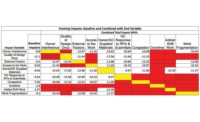In normal times, it is very important to understand the notification requirements in your contract with the general contractor or owner. COVID-19 takes proper and timely notification to another level. How many subcontractors have not been affected by delays to current projects? How many of you have not seen reduced productivity directly related to seemingly overzealous but necessary steps to make the workplace as safe as possible for the workforce? And how many of have experienced projects being put on hold until further notice. COVID-19 will have adverse effects on your planned productivities and the sooner we recognize what those affects are and the effects they will have, the sooner we can provide proper notification. Just because COVID-19 is, to say the least, an unusual situation, and one that is recognized by all parties as having adverse effects to the construction industry, does not mean that the notification requirements do not have to be met. Quite the contrary, with everyone affected, the sooner you provide notification the better off you will be and the chances for recovery will be much better than those that procrastinate and do nothing until it’s too late. COVID-19 has created changed conditions on nearly every construction project and changed conditions must be addressed.
In many cases, relationships or the fear of repercussions influence how we address changes. If we have a history of working well with a particular general contractor, we may be inclined to accept a verbal promise that the general will “take care of us”, rather than following the more official notification clauses outlined in the contract. Taking this type of approach is less than professional and an invitation for disaster. As professionals and representatives of our individual companies, we are duty-bound to approach changes to the work in the methods outlined by the contract.
The contract is very specific on how we are obligated to address changed conditions. We are required to provide “written notice” of the changed condition within 21 days, (or the time frames specifically outlined in your contract), after the occurrence or within 21 days after you first recognize the changed condition. The contract does not give you the option of verbal notification. All notification must be in written form even if you are accused of putting together a “claim.” When asked not to provide written notification we should always respond by stating that “the contract requires me to do so.” Once we overcome this, all too common, hurdle, addressing changes to the work will become routine and, as importantly, you will be perceived as a professional and respected for the way in which you approach your work.
The word “claim” can have ominous overtones, but, in essence, it is only a request for compensation arising from changes to the contracted work. If the owner’s representative issues an RFI or CCD that increases the amount of framing, drywall or taping to the project, your cost proposal for the change is nothing more than a claim, as a matter of right, for payment to perform the additional work.
The increase in actual material units is generally easy to quantify and accepted by all parties as compensable. What is more difficult to quantify are changes to the work that affect your ability to perform the original or changed work, to the productivity levels that you had originally planned. These types of changes are generally related to schedule deviations that force other trades to perform their work in conjunction with yours, force you to perform your work in less time than originally allowed or force you to perform your work out of sequence from the originally scheduled work. Even though these types of changes may not be a physical change to your work, they can have a profound effect on your planned efficiencies and must be addressed, just as we address material increases to the work.
The Northwest Wall and Ceiling Bureau (NWCB) has a publication, Impacts to Labor Productivity in Steel Framing and the Installation of and Finishing of Gypsum Wallboard, explaining these types of changes and provides direction on how to estimate the potential costs. As with addressing costs associated with material changes to the work, it is your responsibility to substantiate claims for compensation related to your planned productivity. As soon as it becomes apparent that schedule deviations or other factors, will negatively affect your productivity, provide written notification to the general contractor. Just as with addressing costs associated with material changes to the work, written notification of the cost impacts to planned productivity should be thorough and easily understood by a third party.
Any change to the contract documents, whether a simple increase in units or, as in this case, related to COVID-19, provides you with an opportunity to review those changes or conditions for additional costs and to submit a “claim” for payment. Treating impacts to the work as a change order request is no different than a change order request for added units/material and, by addressing those costs as they occur provides you with the opportunity to receive equitable payment and to avoid an untimely and difficult claim. The NWCB Labor Productivity publication provides explicit information on recognizing and addressing costs associated with impacts to productivity.
COVID-19 is going to present us with extraordinary challenges, and one of the most pressing challenges will be towards recovery. To that end, the NWCB Labor Productivity Study can be used to provide the contractor with very specific mathematical equations to estimate the potential impact and resulting costs, to supplement the documentation, and to establish the certainty and extent of impact to productivity suffered by the contractor.
While the methods described in this and other industry studies may provide a means for estimating potential costs, it must be clearly understood that these methods serve only to calculate a reasonable cost estimate and not real costs. Specific project documentation is the only definitive means to establish or prove that the contractor has suffered actual or real costs and that compensation is warranted. The contractor must provide timely, written documentation, in conformance with the contract documents, that substantiates the claim that factors outside the contractors control have impacted the contractor’s ability to execute the work as planned and as contracted to perform. Recovery, especially in these times, may prove to be very challenging, and to increase your chances at success, the Northwest Wall and Ceiling Bureau strongly recommends that legal counsel be consulted.










